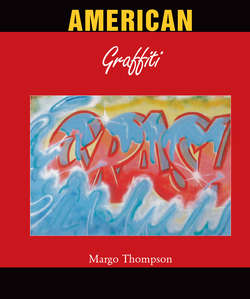American Graffiti

Реклама. ООО «ЛитРес», ИНН: 7719571260.
Оглавление
Margo Thompson. American Graffiti
Introduction
Authenticity
Primitivism
The Avant-Garde
Acknowledgments
Subway Writers
Writing Culture: Social Networks and the Transmission of Skills
Themes
Lettering and Style
Evaluating Quality
BLADE
RAMMELLZEE
NOC 167
QUIK and SEEN
DONDI, FUTURA 2000, ZEPHYR, and LEE
DONDI
FUTURA 2000
ZEPHYR
Graffiti 1980
LEE
LEE and FAB FIVE FREDDY at Galleria la Medusa
FAB FIVE FREDDY
Fashion Moda
CRASH
DAZE
LADY PINK
Graffiti Art: Success for America
Graffiti Art and the East Village Art Scene, 1980–1981
The Times Square Show
Events: Fashion Moda at the New Museum
‘The Fire Down Below’
New York/New Wave
The Lower Manhattan Drawing Show
Beyond Words: Graffiti-Based, – Rooted, and – Inspired Work
Graphiti Productions and Graffiti: Aboveground
The Fun Gallery Opens
‘The Radiant Child’
Graffiti in Galleries
Solo Shows at the Fun Gallery and 51X
Graffiti Art at Fashion Moda
Graffiti Art and the East Village Phenomenon
Graffiti Art in Art in America and Art News
Basquiat’s Solo Show at Fun Gallery
The Pledge of Allegiance
Hubert and Dolores Neumann
Post-Graffiti
Graffiti After Post-Graffiti
Graffiti Art, 1984–1988
Graffiti Artists’ Evaluation of Their Work at Mid-Decade
Basquiat, Haring and Scharf after Post-Graffiti
The East Village: A Status Report
The Contemporary Art Hype
The End of the East Village
American Graffiti in Europe
Graffiti in European Galleries and Museums
Bibliography
Отрывок из книги
MITCH 77, Whole car tag, 1981. Aerosol paint on subway car. New York.
Jean-Michel Basquiat, Keith Haring, and Kenny Scharf are graffiti artists according to art historians and critics, and so are the painters, later featured in galleries, who began their careers ‘writing’ on or ‘tagging’ New York City subway cars.[1]
.....
One of the strategies modern art has used to renew itself is primitivism, the appropriation of forms and motifs from non-Western cultures that are constructed as less civilised and closer to nature than Western society. For example, in the early twentieth century Picasso and Matisse solved the problem of how to represent a modern female form by referencing tribal sculpture from Africa. Primitivism is an attitude that reveals much about white, European society, and next to nothing about the non-European cultures that it has dubbed ‘primitive’. Primitivism does not account for the power and complexity of African, Oceanic, Native American, or Caribbean cultures, but labels them exotic and finds in them certain predictable traits: these Others are represented in the West as simpler, more intuitive, less inhibited. Very often, these stereotypical qualities are judged desirable by the Westerner, such as Gauguin’s Tahitians painted to represent mysticism and sensuality. In the so-called primitive Other, the primitivist finds his preconceptions about himself as sophisticated and civilised and the Other as naïve and natural to be confirmed. Subway writers knew that art world players viewed them with fascination and suspicion but with little real awareness of writing culture or even what it meant to depend upon the subway for transportation. The relationship of dominant culture to subculture that framed graffiti art is paradigmatically primitivist.
Oldenburg’s and Mailer’s choice of words in the quotations above demonstrate how primitivism paved the way for the acceptance of graffiti art in the early 1990s. Graffiti, they marveled, is a ‘bouquet from Latin America’, made by ‘tropical peoples’ who import the ‘giant trees and pretty plants of a tropical rainforest’, the ‘jungle’, to the grey, mechanised urban environment. To Schjeldahl, it is likewise a force of nature, ‘volcanic’ and ‘unstoppable’. Most of the writers were African American, Puerto Rican or South American, or of mixed racial and ethnic heritage. Their cultural difference was reinforced and made visible in the writers’ racial or ethnic identity that set them apart from the predominately white art world. If race was not specifically mentioned in accounts of graffiti art, it was sufficient to locate the writers as ‘ghetto kids’ from the Bronx or Brooklyn to secure their identity as non-white.
.....